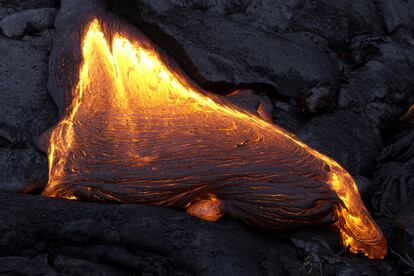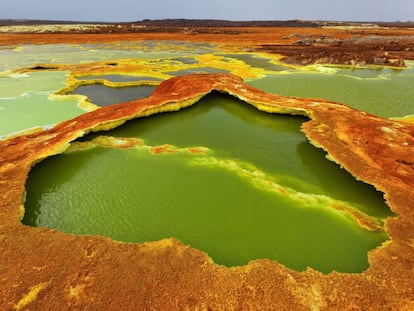Life passes slowly underground
The depths of the Earth are home to an enormous biosphere, a great unknown that holds fundamental keys to the origin, evolution, and survival of life

We inhabit a planet where the exuberance of biodiversity is displayed on its surface in its maximum splendor, and despite this we affirm that life beyond here, for example on Mars, can most likely be found in its subsoil.
At first glance, it may seem somewhat curious to expect that information about life on other planets in our solar system is buried. Although it is true that conditions on the surface of some of these celestial bodies are not at all favorable for life. On Venus, for example, the surface temperature is around 480º Celsius, and it has a toxic, dense, and heavy atmosphere, with more than 90 times the pressure of Earth at sea level and composed almost entirely of carbon dioxide, with clouds of sulfuric acid.
But searching for life underground goes far beyond awareness of the terrible conditions that exist on the surface of many planets and moons out there. It touches on something we are only now beginning to explore and understand on our own planet: the depths of the Earth are home to a vast biosphere that is largely isolated from the surface world. But how does it work? Where does it get its energy?
If there is one thing we are sure of on our planet, the only place in the universe where we are certain of the existence of life, it is that life needs energy. All living beings need to carry out chemical reactions to obtain it, and the amount of energy they obtain from these reactions depends greatly on the conditions of the environment.
The Sun provides abundant energy for the chemical reactions of life on the surface, and it is precisely this demand that drives rapid exchanges of carbon between the atmosphere, oceans, and land. Photosynthesis and respiration of organic carbon at and near the Earth’s surface support this exchange on time scales that are relatively short.
But sunlight cannot penetrate more than a few centimeters into rock, and only up to one kilometer into ocean water. So what happens to life underground? Well, it is very difficult to study how it works.
The Earth’s interior can withstand high temperatures, so we know that cold is not a problem. Water, the other imperative necessity of life, isn’t either. The amount of water in the Earth’s subsoil is up to 100 times greater than that available as fresh water on the surface. The planet beneath the surface is a structure riddled with cracks and underground springs where water runs freely through fractures, even at depths of several kilometers.
The study of life underground poses other problems besides its difficult access. Because it has little accessible energy, it maintains a very relaxed, slow lifestyle, so to speak, which makes it a challenge to cultivate representative microorganisms. These organisms, however, provide new insights into the limits of metabolism. Among other things, microorganisms below the Earth’s surface are extraordinarily long-lived and only divide once every several thousand years. For reference, a common bacterium on the Earth’s surface can double its population every 20 minutes. One of the long-standing questions is how those that live in the deep achieve such a slow lifestyle.
And there are a lot of them: it has recently been estimated that the deep subsurface may contain around 13% of the planet’s biomass. If the top 600 meters of oceanic crust are hydrologically permeable enough to support life, the size of the submerged biosphere beneath that crust is estimated to be 1.8 billion km³ (oceanic crust covers about 70% of the Earth’s surface). Cells have been found at a depth of 2.5 km below the ocean floor, which, if true for the entire continental crust, would translate into a potential habitable volume of over 730 million km³, almost 50% of the volume of the Earth’s oceans.
Studies of this deep ecosystem on Earth have implications in many fields of science, providing new insights into the origin of life. They may provide valuable data for the search for subterranean life on rocky planets such as Mars. Studying seafloor ecosystems may help determine the possible nature of organisms that might inhabit the oceanic moons of Europa and Enceladus.
Even the mere existence of this subterranean life is good news for the search for life on planets and moons in our solar system. If on Earth we have the realization that complex surface life forms can also survive indefinitely in the deep subsurface, it is to be expected that earlier, long before surface conditions became inhospitable on Mars, a similar migration process could have transported life forms to the deep subsurface. And there, or here, they are waiting for us to come and find them.
Sign up for our weekly newsletter to get more English-language news coverage from EL PAÍS USA Edition
Tu suscripción se está usando en otro dispositivo
¿Quieres añadir otro usuario a tu suscripción?
Si continúas leyendo en este dispositivo, no se podrá leer en el otro.
FlechaTu suscripción se está usando en otro dispositivo y solo puedes acceder a EL PAÍS desde un dispositivo a la vez.
Si quieres compartir tu cuenta, cambia tu suscripción a la modalidad Premium, así podrás añadir otro usuario. Cada uno accederá con su propia cuenta de email, lo que os permitirá personalizar vuestra experiencia en EL PAÍS.
¿Tienes una suscripción de empresa? Accede aquí para contratar más cuentas.
En el caso de no saber quién está usando tu cuenta, te recomendamos cambiar tu contraseña aquí.
Si decides continuar compartiendo tu cuenta, este mensaje se mostrará en tu dispositivo y en el de la otra persona que está usando tu cuenta de forma indefinida, afectando a tu experiencia de lectura. Puedes consultar aquí los términos y condiciones de la suscripción digital.
More information
Archived In
Últimas noticias
The complicated life of Francesca Albanese: A rising figure in Italy but barred from every bank by Trump’s sanctions
How Japan is trying to avert ‘digital defeat’
Half of Scotland is in the hands of 420 property owners
Reinhard Genzel, Nobel laureate in physics: ‘One-minute videos will never give you the truth’
Most viewed
- Pablo Escobar’s hippos: A serious environmental problem, 40 years on
- Reinhard Genzel, Nobel laureate in physics: ‘One-minute videos will never give you the truth’
- Why we lost the habit of sleeping in two segments and how that changed our sense of time
- Charles Dubouloz, mountaineering star, retires at 36 with a farewell tour inspired by Walter Bonatti
- The Florida Keys tourist paradise is besieged by immigration agents: ‘We’ve never seen anything like this’










































